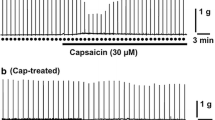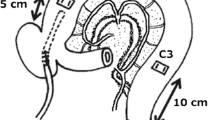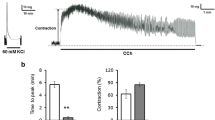Abstract
The effects of capsaicin on [3H]acetylcholine release and muscle contraction were studied on the myenteric plexus-longitudinal muscle preparation of the guinea-pig ileum preincubated with [3H]choline. Capsaicin concentration-dependently increased both basal [3H]acetylcholine release (pEC50 7.0) and muscle tone (pEC50 6.1). The facilitatory effects of capsaicin were antagonized by 1 μM capsazepine (pK B 7.0 and 7.6), and by the combined blockade of NK1 and NK3 tachykinin receptors with the antagonists CP99994 plus SR142801 (each 0.1 μM). This suggests that stimulation by capsaicin of TRPV1 receptors on primary afferent fibres causes a release of tachykinins which, in turn, mediate via NK1 and NK3 receptors an increase in acetylcholine release. The capsaicin-induced acetylcholine release was significantly enhanced by the NO synthase inhibitor L-NG-nitroarginine (100 μM). This indicates that tachykinins released from sensory neurons also stimulate nitrergic neurons and thus lead, via NO release, to inhibition of acetylcholine release. Capsaicin concentration-dependently reduced the electrically-evoked [3H]acetylcholine release (pEC50 6.4) and twitch contractions (pEC50 5.9). The inhibitory effects were not affected by either capsazepine, NK1 and NK3 receptor antagonists, the cannabinoid CB1 antagonist SR141716A or by L-NG-nitroarginine. Desensitization of TRPV1 receptors by a short exposure to 3 μM capsaicin abolished the facilitatory responses to a subsequent administration, but did not modify the inhibitory effects. In summary, capsaicin has a dual effect on cholinergic neurotransmission. The facilitatory effect is indirect and involves tachykinin release and excitation of NK1 and NK3 receptors on cholinergic neurons. The inhibition of acetylcholine release may be due to a decrease of Ca2+ influx into cholinergic neurons.




Similar content being viewed by others
References
Bartho L, Holzer P (1995) The inhibitory modulation of guinea-pig intestinal peristalsis caused by capsaicin involves calcitonin gene-related peptide and nitric oxide. Naunyn-Schmiedeberg's Arch Pharmacol 353:102–109
Bartho L, Vizi ES (1985) Neurochemical evidence for the release of acetylcholine from the guinea-pig ileum myenteric plexus by capsaicin. Eur J Pharmacol 110:125–127
Bartho L, Petho G, Antal A, Holzer P, Szolcsanyi J (1987) Two types of relaxation due to capsaicin in the guinea pig isolated ileum. Neurosci Lett 81:146–150
Bartho L, Lenard L, Patacchini R, Halmai V, Wilhelm M, Holzer P, Maggi CA (1999) Tachykinin receptors are involved in the ''local efferent'' motor response to capsaicin in the guinea-pig small intestine and oesophagus. Neuroscience 90:221–228
Bartho L, Benko R, Lazar Z, Illenyi L, Horvath OP (2002) Nitric oxide is involved in the relaxant effect of capsaicin in the human sigmoid colon circular muscle. Naunyn-Schmiedeberg's Arch Pharmacol 366:496–500
Bartho L, Benko R, Patacchini R, Petho G, Holzer-Petsche U, Holzer P, Lazar Z, Undi S, Illenyi L, Antal A, Horvath OP (2004) Effects of capsaicin on visceral smooth muscle: a valuable tool for sensory neurotransmitter identification. Eur J Pharmacol 500:143–157
Behrendt HJ, Germann T, Gillen C, Hatt H, Jostock R (2004) Characterization of the mouse cold-menthol receptor TRPM8 and vanilloid receptor type-1 VR1 using a fluorometric imaging plate reader (FLIPR) assay. Br J Pharmacol 141:737–745
Benham CD, Davis JB, Randall AD (2002) Vanilloid and TRP channels: a family of lipid-gated cation channels. Neuropharmacology 42:873–888
Bevan S, Hothi S, Hughes G, James IF, Rang HP, Shah K, Walpole CS, Yeats JC (1992) Capsazepine: a competitive antagonist of the sensory neurone excitant capsaicin. Br J Pharmacol 107:544–552
Caterina MJ, Schumacher MA, Tominaga M, Rosen TA, Levine JD, Julius D (1997) The capsaicin receptor: a heat-activated ion channel in the pain pathway. Nature 389:816–824
Debreceni A, Abdel Salam OME, Figler M, Juricskay I, Szolcsanyi J, Mozsik G (1999) Capsaicin increases gastric emptying rate in healthy human subjects measured by C-13-labeled octanoic acid breath test. J Physiol (Paris) 93:455–460
Docherty RJ, Yeats JC, Piper AS (1997) Capsazepine block of voltage-activated calcium channels in adult rat dorsal root ganglion neurones in culture. Br J Pharmacol 121:1461–1467
Furchgott RF (1972) The classification of adrenoceptors (adrenergic receptors). An evaluation from the standpoint of receptor theory. In: Blaschko H, Muscholl E (eds) Catecholamines, Handbook of Experimental Pharmacology, vol 33. Springer, Berlin Heidelberg New York, pp 283–335
Gonzalez R, Dunkel R, Koletzko B, Schusdziarra V, Allescher HD (1998) Effect of capsaicin-containing red pepper sauce suspension on upper gastrointestinal motility in healthy volunteers. Dig Dis Sci 43:1165–1171
Holzer P (2004) TRPV1 and the gut: from a tasty receptor for a painful vanilloid to a key player in hyperalgesia. Eur J Pharmacol 500:231–241
Holzer P, Holzer-Petsche U (1997) Tachykinins in the gut. Part I. Expression, release and motor function. Pharmacol Ther 73:173–217
Holzer-Petsche U, Seitz H, Lembeck F (1989) Effect of capsaicin on gastric corpus smooth muscle of the rat in vitro. Eur J Pharmacol 162:29–36
Jerman JC, Brough SJ, Prinjha R, Harries MH, Davis JB, Smart D (2000) Characterization using FLIPR of rat vanilloid receptor (rVR1) pharmacology. Br J Pharmacol 130:916–922
Kang JY, Alexander B, Math MV, Williamson RC (1993) The effect of chilli and its pungent ingredient capsaicin on gastrointestinal transit in the rat. J Gastroenterol Hepatol 8:513–516
Kilbinger H, Wessler I (1980) Inhibition by acetylcholine of stimulation-evoked release of 3H-acetylcholine from the guinea-pig myenteric plexus. Neuroscience 5:1331–1340
Kilbinger H, Wolf D (1994) Increase by NO synthase inhibitors of acetylcholine release from guinea-pig myenteric plexus. Naunyn-Schmiedeberg's Arch Pharmacol 349:543–545
Kilbinger H, Stauß P, Erlhof I, Holzer P (1986) Antagonist discrimination between subtypes of tachykinin receptors in the guinea-pig ileum. Naunyn-Schmiedeberg's Arch Pharmacol 334:181–187
Lee KJ, Vos R, Tack J (2004) Effects of capsaicin on the sensorimotor function of the proximal stomach in humans. Aliment Pharmacol Ther 19:415–425
Lefebvre RA, De Beurme FA, Sas S (1991) Relaxant effect of capsaicin in the rat gastric fundus. Eur J Pharmacol 195:131–137
Liu L, Simon SA (1997) Capsazepine, a vanilloid receptor antagonist, inhibits nicotinic acetylcholine receptors in rat trigeminal ganglia. Neurosci Lett 228:29–32
Lomax AE, Bertrand PP, Furness JB (1998) Identification of the populations of enteric neurons that have NK1 tachykinin receptors in the guinea-pig small intestine. Cell Tissue Res 294:27–33
Maggi CA, Meli A, Santicioli P (1987) Four motor effects of capsaicin on guinea-pig distal colon. Br J Pharmacol 90:651–660
Mang CF, Geber C, Kilbinger H (2000) Effects of capsaicin on acetylcholine (ACh) release from guinea-pig myenteric plexus. Naunyn-Schmiedeberg's Arch Pharmacol 361:R 22
Mang CF, Erbelding D, Kilbinger H (2001) Differential effects of anandamide on acetylcholine release in the guinea-pig ileum mediated via vanilloid and non-CB1 cannabinoid receptors. Br J Pharmacol 134:161–167
Patacchini R, Bartho L, Holzer P, Maggi CA (1995) Activity of SR 142801 at peripheral tachykinin receptors. Eur J Pharmacol 278:17–25
Rinaldi–Carmona M, Barth F, Heaulme M, Shire D, Calandra B, Congy C, Martinez S, Maruani J, Neliat G, Caput D, Ferrara P, Soubrié P, Brelière JC, Le Fur G (1994) SR141716A, a potent and selective antagonist of the brain cannabinoid receptor. FEBS Lett 350:240–244
Rodriguez Stanley S, Collings KL, Robinson M, Owen W, Miner PB (2000) The effects of capsaicin on reflux, gastric emptying and dyspepsia. Aliment Pharmacol Ther 14:129–134
Schwörer H, Schmidt WE, Katsoulis S, Creutzfeldt W (1991) Calcitonin Gene-Related Peptide (CGRP) Modulates Cholinergic Neurotransmission in the Small Intestine of Man, Pig and Guinea-Pig via Presynaptic CGRP Receptors. Regul Pept 36:345–358
Sim JH, Kim YC, Kim SJ, Lee SJ, Suh SH, Jun JY, So I, Kim KW (2001) Capsaicin inhibits the voltage-operated calcium channels intracellularly in the antral circular myocytes of guinea-pig stomach. Life Sci 68:2347–2360
Szallasi A, Blumberg PM (1999) Vanilloid (Capsaicin) receptors and mechanisms. Pharmacol Rev 51:159–212-
Acknowledgments
This study was supported by the Deutsche Forschungsgemeinschaft (Ki 210/10). We thank the pharmaceutical companies (Sanofi, Pfizer) for donation of drugs.
Author information
Authors and Affiliations
Corresponding author
Rights and permissions
About this article
Cite this article
Geber, C., Mang, C.F. & Kilbinger, H. Facilitation and inhibition by capsaicin of cholinergic neurotransmission in the guinea-pig small intestine. Naunyn Schmied Arch Pharmacol 372, 277–283 (2006). https://doi.org/10.1007/s00210-005-0021-6
Received:
Accepted:
Published:
Issue Date:
DOI: https://doi.org/10.1007/s00210-005-0021-6




